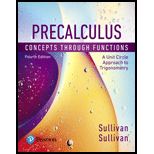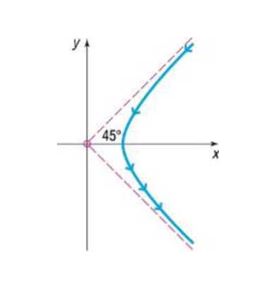
Concept explainers
Rutherford’s Experiment In May 1911, Ernest Rutherford published a paper in Philosophical Magazine. In this article, he described the motion of alpha particles as they are shot at a piece of gold foil 0.00004 cm thick. Before conducting this experiment, Rutherford expected that the alpha particles would shoot through the foil just as a bullet would shoot through snow. Instead, a small fraction of the alpha particles bounced off the foil. This led to the conclusion that the nucleus of an atom is dense, while the remainder of the atom is sparse. Only the density of the nucleus could cause the alpha particles to deviate from their path. The figure shows a diagram from Rutherford’s paper that indicates that the deflected alpha particles follow the path of one branch of a hyperbola.

(a) Find an equation of the asymptotes under this scenario.
(b) If the vertex of the path of the alpha particles is 10 cm from the center of the hyperbola, find a model that describes the path of the particle.
Want to see the full answer?
Check out a sample textbook solution
Chapter 9 Solutions
Precalculus: Concepts Through Functions, A Unit Circle Approach to Trigonometry (4th Edition)
- Solve by DrWz WI P L B dy Sind Ⓡ de max ⑦Ymax dx Solve by Dr ③Yat 0.75m from A w=6KN/M L=2 W2=9 kN/m P= 10 KN Solve By Drarrow_forwardHow to find the radius of convergence for the series in the image below? I'm stuck on how to isolate the x in the interval of convergence.arrow_forwardDetermine the exact signed area between the curve g(x): x-axis on the interval [0,1]. = tan2/5 secx dx andarrow_forward
- A factorization A = PDP 1 is not unique. For A= 7 2 -4 1 1 1 5 0 2 1 one factorization is P = D= and P-1 30 = Use this information with D₁ = to find a matrix P₁ such that - -1 -2 0 3 1 - - 1 05 A-P,D,P P1 (Type an integer or simplified fraction for each matrix element.)arrow_forwardMatrix A is factored in the form PDP 1. Use the Diagonalization Theorem to find the eigenvalues of A and a basis for each eigenspace. 30 -1 - 1 0 -1 400 0 0 1 A= 3 4 3 0 1 3 040 3 1 3 0 0 4 1 0 0 003 -1 0 -1 Select the correct choice below and fill in the answer boxes to complete your choice. (Use a comma to separate vectors as needed.) A basis for the corresponding eigenspace is { A. There is one distinct eigenvalue, λ = B. In ascending order, the two distinct eigenvalues are λ₁ ... = and 2 = Bases for the corresponding eigenspaces are { and ( ), respectively. C. In ascending order, the three distinct eigenvalues are λ₁ = = 12/2 = and 3 = Bases for the corresponding eigenspaces are {}, }, and { respectively.arrow_forwardN Page 0.6. 0.4. 0.2- -0.2- -0.4- -6.6 -5 W 10arrow_forward
 Trigonometry (MindTap Course List)TrigonometryISBN:9781337278461Author:Ron LarsonPublisher:Cengage Learning
Trigonometry (MindTap Course List)TrigonometryISBN:9781337278461Author:Ron LarsonPublisher:Cengage Learning
